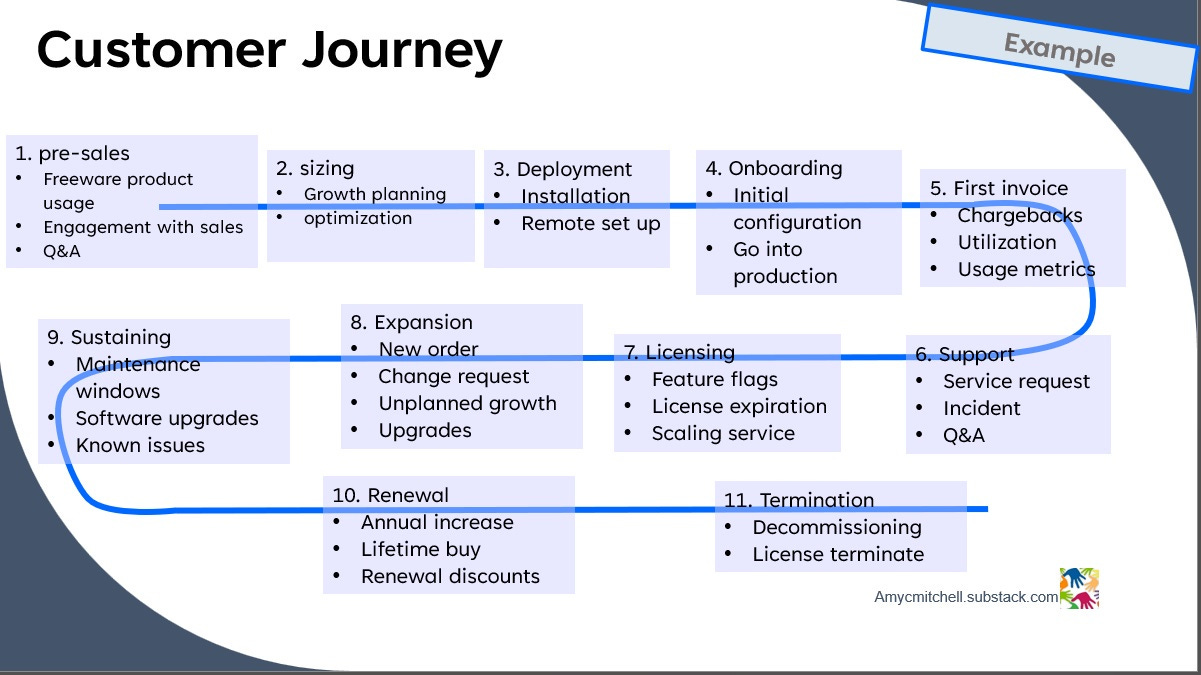Is your customer journey map getting much usage in product development? If you dust it off every time you do requirements, you are missing an opportunity to tie your customer journey into daily product operations.
Customer journey maps and examples are covered in this article: Customer Insights with a Customer Journey Map
A case study of a team with no customer journey map is found here: Overcoming challenges through customer journey mapping
Let's dive into a case study of a product with a check-the-box customer journey.
Case Study Background
A software-as-a-service (Saas) product is growing slower than planned. The early customers have had a variety of issues activating service and growing. Each issue spawns a lot of internal discussion about accountability. Sales, engineering, finance, and product management have different perspectives on the root causes.
The customers are pleased with the service. From the customer's point of view, there aren't issues except delayed responses to service requests.
The Challenge for the Product
The growth of the SaaS product is stunted. The product team is improvising the operational principles to respond to customer needs.
The product team has a high-level customer journey map. There are few details about how the team operates together on behalf of the customer.
Here are some early customer problems that aren't addressed in the customer journey map:
Each customer has a different term of service and different service activation milestones
Customers are requesting expansions very quickly after activation
Some customers have not consumed the SaaS product as planned
Special requests made during the sales cycle aren't being tracked
The product team has been very resourceful and put the customer needs ahead of the product needs.
Breaking Through the Challenge to Scaling
With new customers arriving, the subject matter experts were getting stretched thin to keep coming up with creative solutions to every customer request. The sales team frequently came up with different solutions to the same problem!
To make matters worse, the whole product team spent a lot of time on each customer. High-revenue customers got the same effort as low-revenue customers.
As the product grows, the level of customization needs to be reduced. A better approach is to handle the low-revenue customers in bulk while doing personalization on the high-revenue customers.
How Does This Relate to a Customer Journey Map?
In this case, the product managers created a customer journey map and archived it. It was a check-the-box customer journey that wasn't detailed enough to be used with customers.
The subject matter experts carried the customer journey details in their heads. There was minimal sharing of best practices or learnings from handling the early customers. The team came together to fix problems and quickly moved on to the next problem.
The product managers focused on adding operational principles to the customer journey map.
Case Study With Operational Principles in the Customer Journey Map
Suppose on this same product, the product managers had more details in the customer journey map. Instead of a check-the-box customer journey map, the product managers establish operational principles to complement the customer journey map.
Here is the customer journey map from the product managers:
Here are the operational principles that the product managers propose:
The product managers revise these principles into a workflow with the product team. The below diagram shows the resulting workflow:
How Could a Customer Journey Map with Operational Principles Help?
In this case study, the customer journey map with the operational principles would reduce the exceptions and the profitability risk to the SaaS product.
The customers get a more unified service and the SaaS product team responds to customer needs faster:
Based on the customer order, the service activation and term are known to the customer and the product team
Expansion requests are automated based on the customer's order
Special requests are handled consistently by the subject matter experts
With upfront investment in the operational principles, customer requests are handled consistently. Operational principles reduce the daily decisions in delivering service to SaaS customers.
Conclusion - Moving Away from Check-the-Box Customer Journeys
Product managers get value by visualizing the customer experience with a customer journey map. When product managers document operational principles for the whole product team, customers benefit from a unified experience.
The lessons learned from this case study are:
Operational principles empower independent work: teams operate in the same operational context in terms of customer milestones, expansions, and business risks
Relationships matter: documented principles provide a stable foundation for teams to work together
Controlled customization is best: optimize subject matter expert time by escalating special requests to them
Take your customer experience to the next level by adding operational principles to your customer journey map. Collaborating on the operational principles provides a foundation for teams to deliver a consistent customer experience. This is a key step to scaling to a repeatable service that is efficient.
Want to know what happened after a recent article? Premium subscribers get a peak behind the scenes of a recent newsletter. Last week’s backstory was about good and bad persuasion in product management. Persuasion without Manipulation
To celebrate my first year of paid subscriptions, I’ve lowered the paid subscription rate.
Connect to Amy on LinkedIn, Threads, Instagram and X/Twitter








